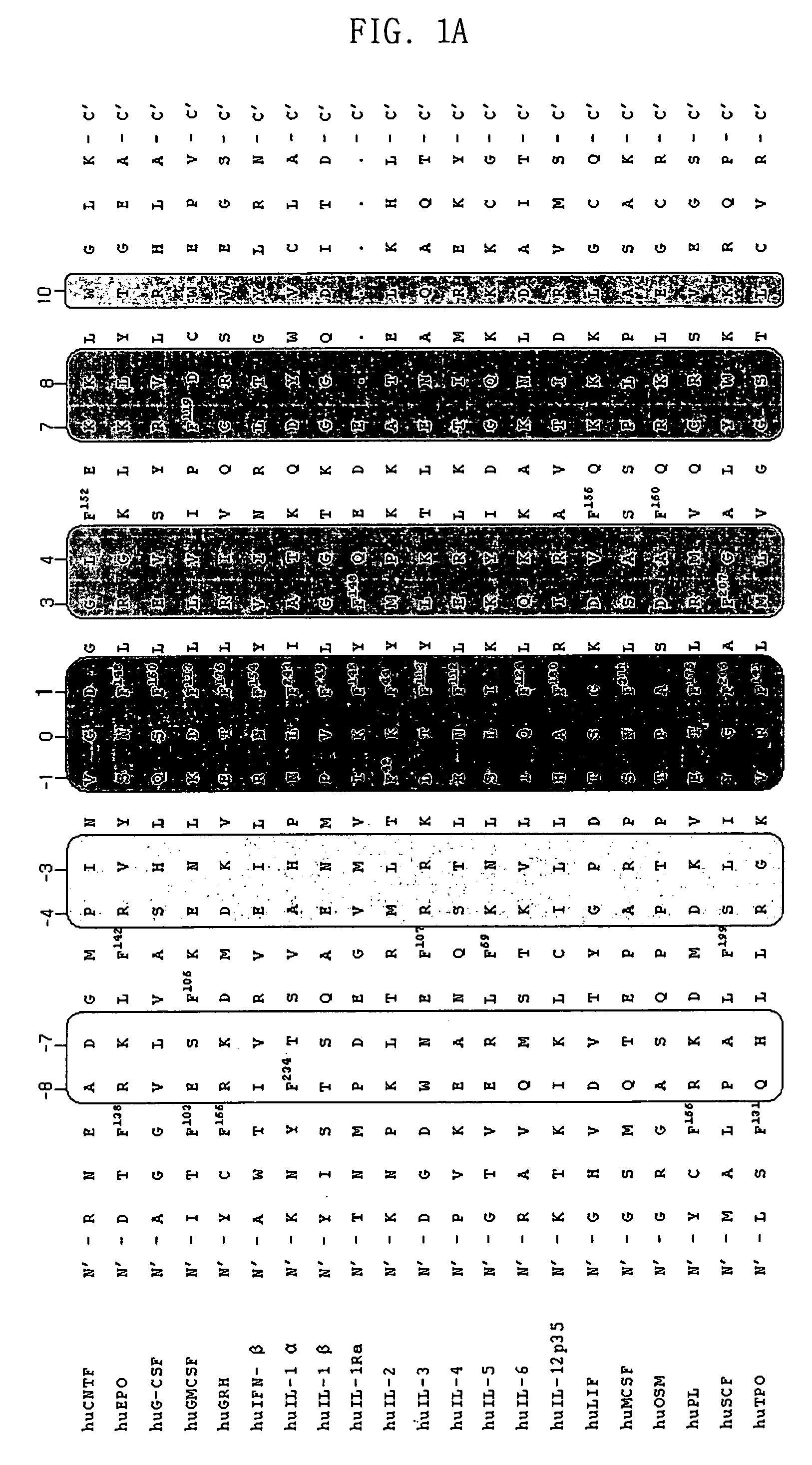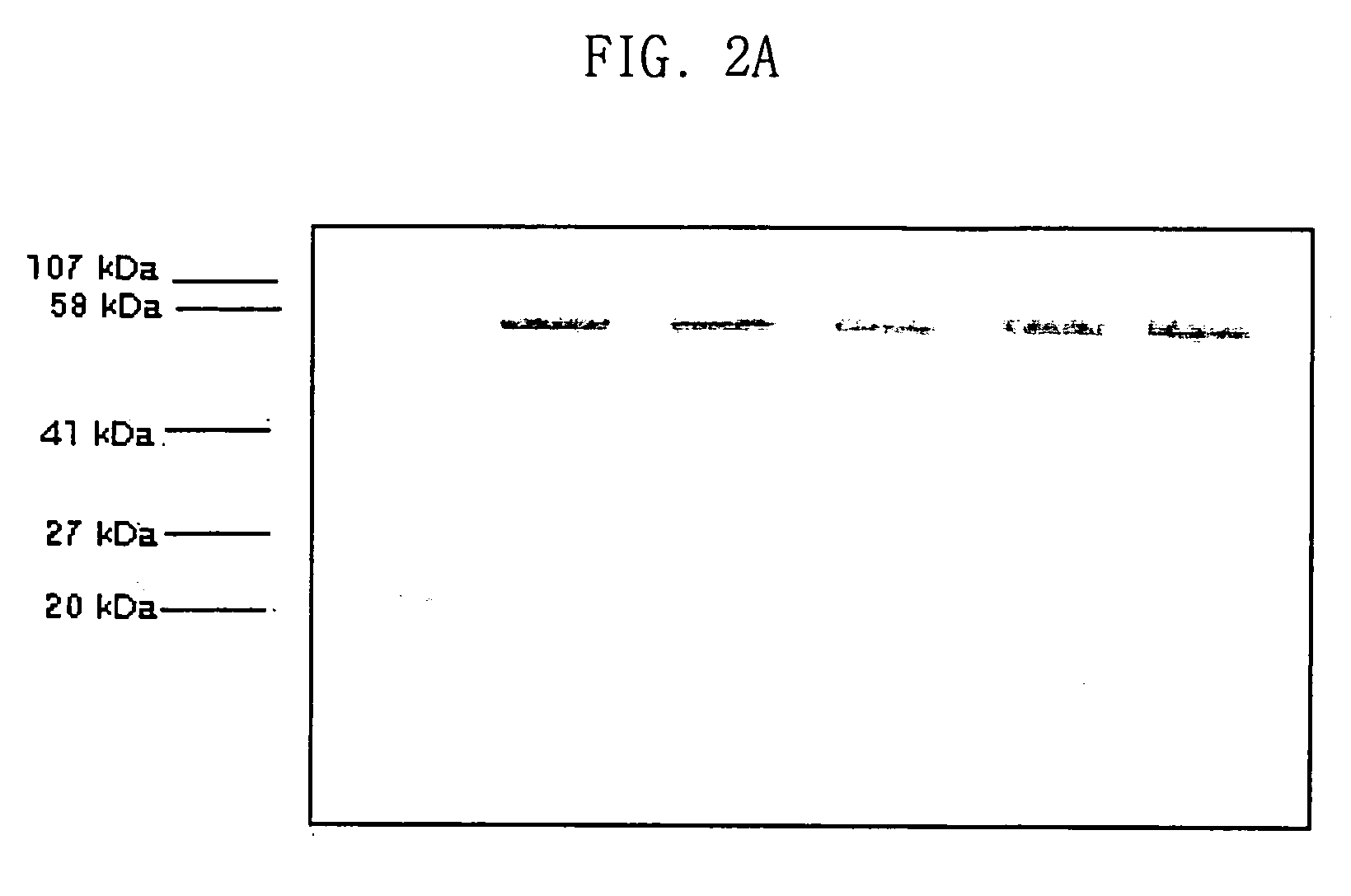Method of improving efficacy of biological response-modifying proteins and the exemplary muteins
a biological response and mutein technology, applied in the field of protein variants, can solve the problems of cumbersome methods, affecting the homogeneity of final products, and many physiologically active proteins used as medicines are easily degraded in serum, so as to maximize the biological response modifying effect, prevent the formation of blocking antibodies, and improve the effect of pharmacological action
- Summary
- Abstract
- Description
- Claims
- Application Information
AI Technical Summary
Benefits of technology
Problems solved by technology
Method used
Image
Examples
example 1
[0096] Construction of DNA Coding Wild Type TPO / EPO / G-CSF / GH
[0097] A. Construction of DNA Coding Wild Type TPO
[0098] 750 μl of TRIzol reagent (MRC., USA) was added to bone marrow tissue in a microcentrifuge tube and incubated at room temperature for 5 minutes. 200 μl of chloroform was added into the tube and then the tube was shaken vigorously for 15 seconds. After incubating the tube at room temperature for 2-3 minutes, it was centrifuged at 15,000 rpm for 15 minutes at 4° C. The upper phase was transferred to a 1.5 ml tube and 500 μl of isopropanol was added. The sample was incubated at −70° C. for 30 minutes and centrifuged at 15,000 rpm for 15 minutes at 4° C. After discarding supernatant, RNA pellet was washed once with 75% DEPC ethanol by vortexing and centrifuged at 15,000 rpm for 15 minutes at 4° C. The supernatant was removed and the RNA pellet was dried for 5 minutes at room temperature and then the pellet was dissolved in 50 μl of DEPC-treated 3° distilled water.
[0099]...
example 2
Construction of cDNA coding TPO / EPO / G-CSF / GH Muteins
[0112] A. Construction of cDNAs Coding TPO Muteins
[0113] Four muteins of TPO, TPO-[F46V], TPO-[F128V], TPO-[F131V] and TPO-[F141V] were constructed according to procedures as follows to have a single amino acid-substitution from phenylalanine to valine at each positions, respectively.
TABLE 1Primers used in constructing cDNAs coding TPO- wild type and muteinsPrimer No.Nucleotide sequenceSequence No.1Wild type TPOSense5′-CGGAATTCCGATGGAGCTGACTGAATTG-3′262Antisense5′-TTTAGCGGCCGCATTCTTACCCTTCCTGAG-3′273 TPO-[F46V]SenseT34Antisense5′-CCAAGCTAACGTCCACAGCAG-3′285TPO-[F128V]SenseT36antisense5′-GCTCAGGACGATGGGAT-3′297TPO-[F131V]SenceT38antisense5′-GGTGTTGGACGCTCAGGAAGATG-3′309TPO-[F141V]SenseT310antisense5′-CATCAGGACACGCACCTTTCC-3′31
[0114] cDNA which code TPO-[F46V], TPO[F128V], TPO-[F131V] and TPO-[F141V] was constructed by primary PCR using specific primers (Table 1) and universal primer T3 and secondary PCR using the primary PCR pro...
example 3
Expression and Purification of TPO Muteins
[0133] A. TPO Muteins
[0134] a Establishments of Transfected Cell Lines by Using Lipofection Method
[0135] Chinese hamster ovary (“CHO-K1”)(ATCC, CCL61) cells were prepared at a density 1.5×105 cells per 35 mm dish containing Dulbecco's modified Eagle's medium (“DMEM”)[Gibco BRL, USA] supplemented with 10% fetal bovine serum (“FBS”). The cells were grown at 37° C. in a 5% CO2 for 18-24 hrs. 6 μl of Lipofectamne was added to 1.5 μg of the recombinant expression vector comprising DNA coding TPO mutein in a sterile tube. Volume of his mixture was adjusted to 100 μl by adding serum-free DMEM. The tube was incubated at room temperature for 45 min. The cells grown in 35 mm dish were washed twice with serum-free DMEM and 800 μl of serum-free DMEM was added to the dish. The washed cells were gently overlaid on the lipofectamine-DNA complex and then incubated for 5 hrs at 37° C. in 5% CO2. Aeer 5 hrs incubation, 1 ml of DMEM containing 20% FBS was a...
PUM
 Login to View More
Login to View More Abstract
Description
Claims
Application Information
 Login to View More
Login to View More - R&D
- Intellectual Property
- Life Sciences
- Materials
- Tech Scout
- Unparalleled Data Quality
- Higher Quality Content
- 60% Fewer Hallucinations
Browse by: Latest US Patents, China's latest patents, Technical Efficacy Thesaurus, Application Domain, Technology Topic, Popular Technical Reports.
© 2025 PatSnap. All rights reserved.Legal|Privacy policy|Modern Slavery Act Transparency Statement|Sitemap|About US| Contact US: help@patsnap.com



